

 The Accurate Reloading Forums
The Accurate Reloading Forums  THE ACCURATE RELOADING.COM FORUMS
THE ACCURATE RELOADING.COM FORUMS  Guns, Politics, Gunsmithing & Reloading
Guns, Politics, Gunsmithing & Reloading  Reloading
Reloading  Stoney Point OAL "Thingy" Vrs. Cleaning Rod Method
Stoney Point OAL "Thingy" Vrs. Cleaning Rod MethodGo  | New  | Find  | Notify  | Tools  | Reply  |  |
| One of Us |
I thought some of y'all would find this interesting and helpful. I've been using the Cleaning Rod Methodto determine Maximum Overall Cartridge Length (Max COAL). During the time I've been using the method, I have heard lots of talk here on the Forum and even from respected gunsmiths on the crudeness and unreliability of the method to get accurate, repeatable measurements. I rather enjoy the banter here between Hot Core and Woods about the need and usefullness of specialized tools for taking precise measurements in all facets of handloading. Well, last night I decided to use the Scientific Method (Kinda) and see for myself! I have a friend who owns the Stoney Point tool so I made a trip over to his garage with my Dewey cleaning rod. We pulled his .223 varmint rifle out of the safe and began the test. We carfully used the Stoney Point tool to take measurements with the 52 grain Sierra Match Kings he loves. We performed the measurements 3 times and came up with 3 different figures. The discrepency between the longest and shortest measurement was .006". Then, armed with only my rod and a roll of masking tape, I performed the Cleaning Rod Method with the same bullet. I performed the measurement similarly 3 times. The measurements were fairly consistent with an extreme spread of .010". One of the measurements was identical to the measurement taken by the Stoney Point tool. Conclusions and suppositions: I think that the force used to push the bullet into the lands with both methods causes varience in measurements. It takes some experience and practice to use the Cleaning Rod. Accurate placement of the tape on the rod and accurately measuring the distance between the marks is where error can occur. Maybe the marketed cleaning rod stops you can buy are a solution. I think that the Cleaning Rod works just as well as the purchased tool. Realize you have to purchase or make a modified case for every caliber you load for as well. The Cleaning Rod is cheaper and just as effective. | ||
|
| one of us |
There is a more accurrate, cost free, easyer method. But it is too simple and a top secret | |||
|
| one of us |
Graybird "Make no mistake, it's not revenge he's after ... it's the reckoning." | |||
|
| one of us |
Just my opinion after using both, but I believe the cleaning rod method is more accurate from the two choices given because it takes into account the actual measurement to the bolt face and not just a fake cartridge jammed into a chamber. Thier is a headspace issue that the Stoney Point thingy does not account for, however small it might be. My method is much less scientific and most assuredly not as accurate. I make a dummy case for each bullet I care about, mark, or smoke the bullet and play with the seating depth until I barely see the lands contact the marking. I call that the OAL to the lands for that case and bullet. I realize that the bullet tips deform, but if I really cared, I would use the comparator to measure from the ogive. Larry "Peace is that brief glorious moment in history, when everybody stands around reloading" -- Thomas Jefferson | |||
|
| One of Us |
Yes larry, I tried the "dummy case" deal and did it how you say. I came up with a measurement that was .090" longer than with the Cleaning Rod. I think the bullet can contact the lands without leaving marks from the lands. I think you may be able to jam the bullet into the lands quite a way until marks are actually left on the ogive. That's the only way I can account for the 90 thousanths longer OAL with that method. | |||
|
| one of us |
make a chamber cast and you will not have to guess. | |||
|
| One of Us |
Methods, tools that actually work: http://www.grafs.com/product/268330 http://www.brownells.com/userdocs/learn/Inst-446.pdf If the enemy is in range, so are you. - Infantry manual | |||
|
| One of Us |
amamnn, Just look at the cost of that precision mic......49.95 for one caliber. The Cleaning Rod you already have and you'll get the same results. I think the cleaning rod stops would be a great addition. You can probably make your own too. hivelosity, What about throat erosion? You'll have to make a cast every hundred rounds you shoot! | |||
|
| one of us |
| |||
|
| One of Us |
I've seen that tool while surfing Sinclair's site. I just called them since there is no instructions for how the tool is used on their site. The gentleman was very knowledgeable and explained its use well. I see the same problems with this tool as with others. 1. You have to use a fired case that you "jam" into the chamber, thus there may be an error of headspace like larry said in his post. 2. The gentleman actually confirmed my suspicion about the varience of how hard the bullet is pushed into the lands. He says he steel wools the bullet to remove the slickness and burnish. He says it helps him identify the marks from the lands easier. He stated that the guilding metal bullets actually slide into the lands a certain distance before you can see marks. When he sees the marks made about the thickness of his thumbnail (very precise measurement I may add) he seats his bullets a touch deeper (another very precise, measurable distance). The good thing is that this tool does not require "modified cases" to purchase. I think the cleaning rod with good stops on it will work the same. | |||
|
One of Us |
Hey rc, et al (except you HC The cleaning rod has several things that make it problematic for getting an accurate DTL (distance to lands) measurement. First is that there is not a good flat attachement that I am aware of to use on the end. Jags have points to poke and hold patches and that point may hit the bolt face or may hit the firing pin. When it hits the bullet the point will slide to one side or the other. If you don't use a cleaning rod attachement then that will leave a female threaded hole which will work well on the bolt face but will create a problem on the bullet meplat. Then you get to the marking of the rod. Let me ask you, which one of the following pics is the correct measurement? 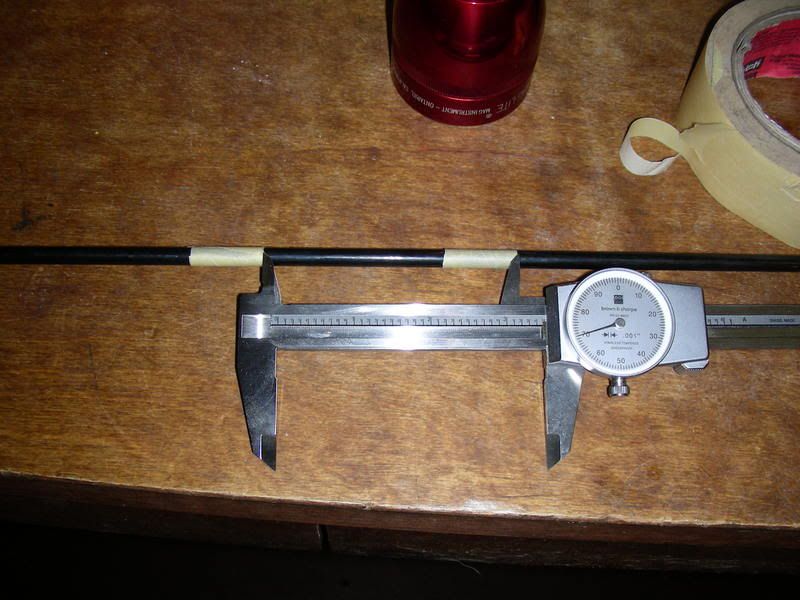 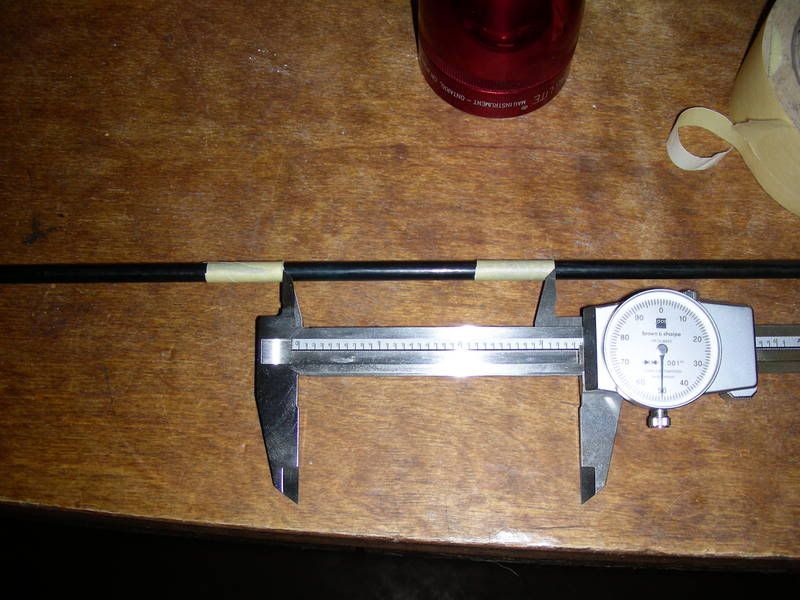  Add the inaccuracy of trying to mark the tape in the same place everytime 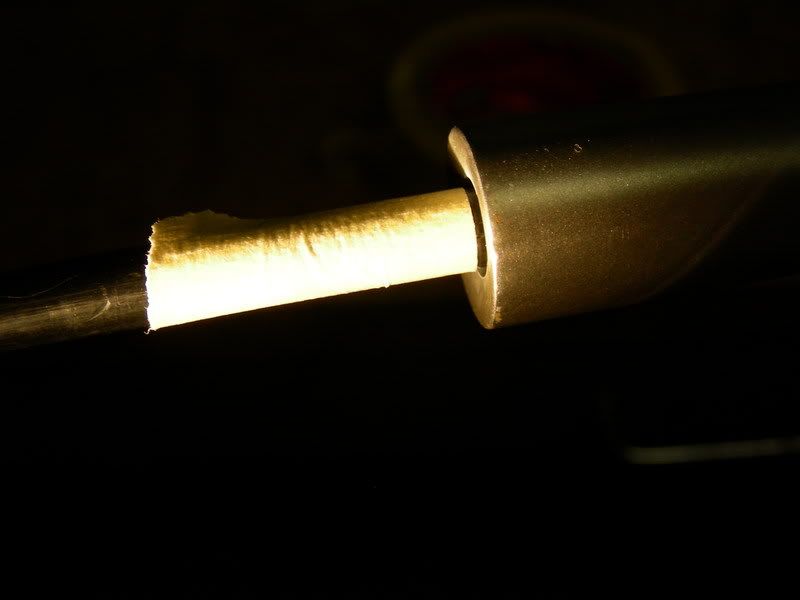 and you are just "in the ballpark". The Sinclair shows a pic on their site but it does not show the "delrin action guide" which may or may not fit in your action. I found it worked on very few of my rifles and the biggest problem was getting the knurled lock screw was a problem to get locked down 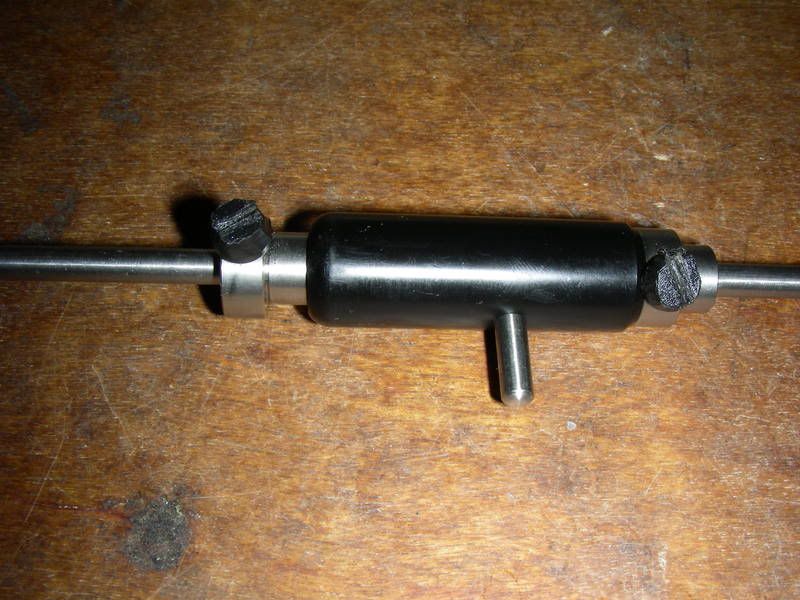 notice the home made slot for a screwdriver to help tighten (still slipped sometimes). The Hornady Gauge is not perfect for 2 reasons. One is that it is not fool proof (hey HC, how you doing? The best way to measure is to use the R-P tool or something similar. It is a stainless steel rod with 2 lockable collets and a brass tip shown here with the Hornady 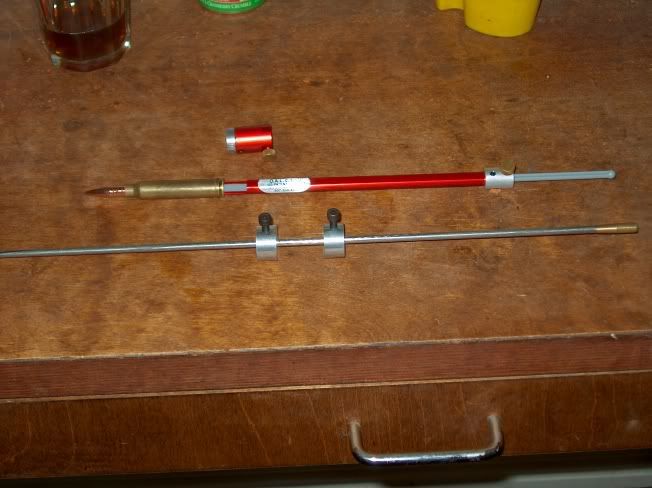 It has a removable brass tip    you only have to remove the brass tip if the caliber is 25 or below. The way it works is to run the rod down the muzzle to the bolt face (make sure it is cocked) and lock the outside collet 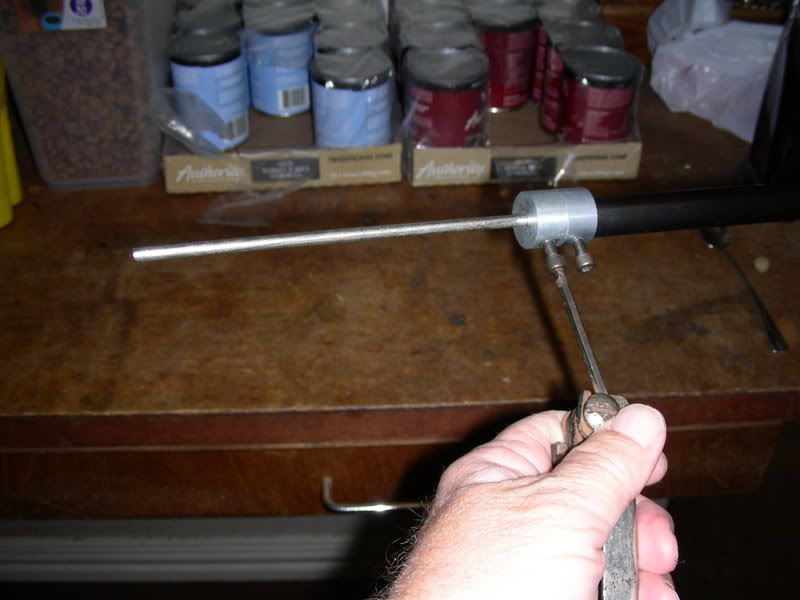 remove the bolt and hold a bullet against the lands, the Hornady OAL thingy makes an excellent tool for inserting the bullet or hold it with a dowel 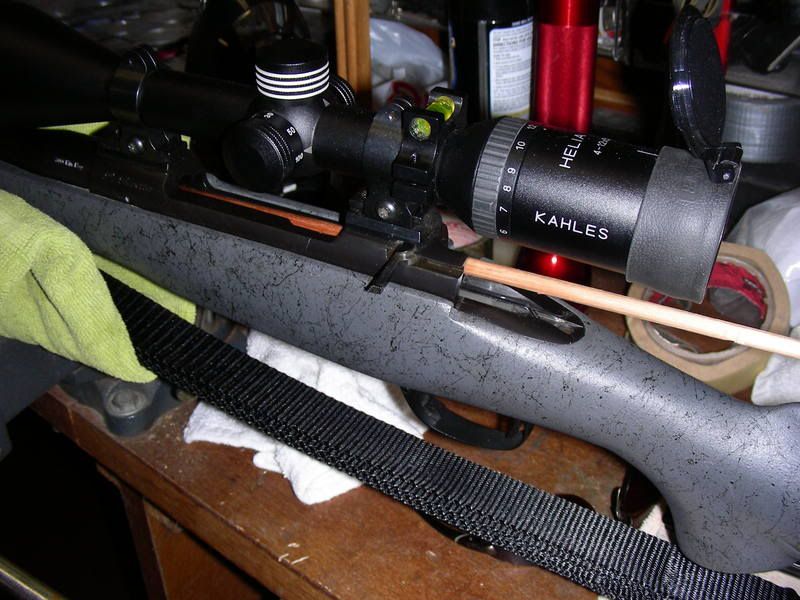 insert the rod down the muzzle to the bullet tip and lock the inside collet 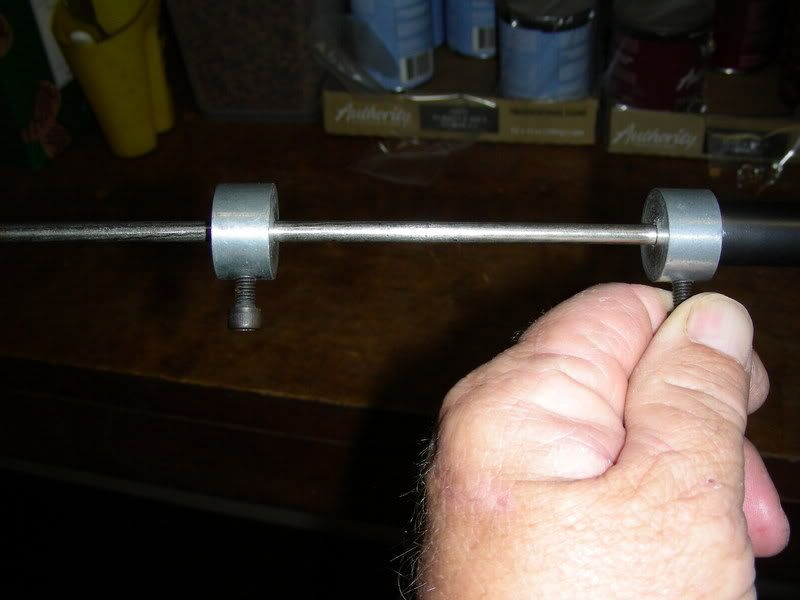 measure between the collets 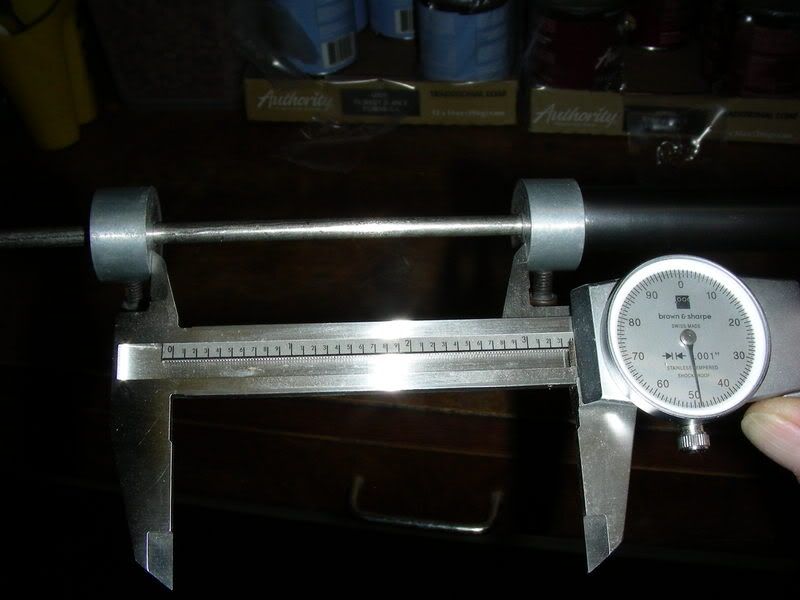 Now HC, put your $7.00 WalMart glasses on and look at that pic, is there any way you can not get a perfect measurement when measuring between 2 hard surfaces like that? Much better than trying to interpolate the measurement between 2 imprecisely placed pieces of tape with edges that could be +-.005" off on either end? Then all you have to deal with is how far your case is going to travel in your chamber when fired, which will reduce you DTL. An example would be with new cases. If you had a new case with .015" headspace then the bullet location would be .015" less when it finishes moving. So if you had new cases and thought you were seating .010" off the lands then you would actually be on the lands when the case fired. BTW, I do not know about the RCBS Precision Mic but I am with you rc, at $50.00 a caliber that is out of the question. I'll take the R-P tool that costs $25.00 and will work for every caliber. ____________________________________ There are those who would misteach us that to stick in a rut is consistency - and a virtue, and that to climb out of the rut is inconsistency - and a vice. - Mark Twain | Chinese Proverb: When someone shares something of value with you and you benefit from it, you have a moral obligation to share it with others. ___________________________________ | |||
|
| One of Us |
Stony Point is pretty darn good when you get the right feel. I've checked it with low-to-no tension/partial neck sized and waxed TSX (BTs which have litle bearing length and the grooves hold the wax as well)chambered rounds. Those are the only methods I like. I sure as shit don't put in a cleaning rod in a barrel unless I absolutely have to......... There are two types of people in the world: those that get things done and those who make excuses. There are no others. | |||
|
| One of Us |
I have had good luck using a slight variation on the 'tape method'. I tape the rod where part of the tape is inside the muzzle. I lay a straightedge across the crown and use it to mark the tape with a pencil. My Stoney point measurements are usually within .002. Using a fireformed piece of brass that has been slightly necksized to hold the bullet also measures within .002. | |||
|
| One of Us |
I like the method I learned here on AR: With a cut off wheel in a dremel slice across both sides of the neck of a case to just touching the shoulder. Slip your bullet in but not far enough. Gently chamber the round and close the bolt. Open and gently remove so as not to disturb the position of the bullet in the neck. I apply a drop of super glue on the neck slit to lock the bullet in place then write on the cartridge which gun it came from. I never measure COL. I use the Hdy guage to measure COgL (cartridge ogive length). In all but one of my magazine guns the throat is quite a bit longer than the magazine will allow for COL. With these I just seat to the depth of the caliber with great results. | |||
|
| one of us |
Our esteemed Mr. Woods does make a fine "Point"(pun intended). It is amazing how many of us are able to figure out that the "Point" he refered to is Brass and is easily removed with a File or small Dremel style tool. And the $$$Cost$$$ savings over the non-accurate "Thingys" is in a ratio of about $50 vs. $1 give or take a little. Depending on the size of the Jag selected, it can be used with more than one Caliber without slipping past the Bullet Tip. So, you do not need a new "Thingy" for each and every Caliber. ----- But, this next part is what makes all the high precision measuring of minor importance. You simply need to be "close" to the actual distance. The reason for that is the Final Load(based on using the best Harmonic Node to start with) needs to be Fine Tuned by varying the Seating Depth. So, if you want to Jam-the-Lands, you locate a "Close - Kiss-the-Lands - Measurement" for your First Bullet from a new Box. Determine OCL, convert to ODL and Seat the Bullets 0.005"-0.010" Into-the-Lands. You can tell when closing the Bolt if 0.010" is too tight and causes the Bullet to slip. Then 0.005" is probably just fine to hold Tension on the Bullet. The other situation is used with most of our Hunting Cartridges where we do not want the Bullet Seated Into-the-Lands. Once you have the ODL, it is a simple task to assemble any number of Cartridges any distance you desire Off-the-Lands. Then you shoot them to see which ODL works the best, based on that Harmonic Node. So, fretting over the Headaches of a relatively $$$Expensive$$$ "Thingy", compared to a $1 Jag simply means the Thingy User just hasn't thought his way through the entire Reloading Process. Or..., he just loves wasting money on Thingys. Best of luck to you all. | |||
|
| One of Us |
Thanks for all the input gentlemen. Woods, we know we can always count on you to go the extra mile on your posts! Great pics and descriptions of uses and problems with all the tools! Nice pic of the Bourbon on the bench too! I have had good luck with just the plastic jag that was in a cheap Outers cleaning kit. I simply snipped off the point on the end with a nail clipper. Measurements have been repeatably consistent even with the masking tape method, which is marginal as you have shown. I've noticed the same problem. I have ordered some Sinclair rod stops and think they will yield better results similar to your R-P tool. I believe as well that HC is correct as to just having to be close to exactly right. Think of all the times you've seated bullets and gone to measuring OAL. They vary due to bullet lengths, neck tension, ogive variences. You can't chase the OAL around with every bullet you seat therefore each round may differ in actual ogive-to-lands measurement by thousanths... | |||
|
| One of Us |
Fully agree, dropped the NEW!, IMPROVED!, "high tech" things and went back to low tech a few years ago. I have both the Stoney Point and RCBS tools but don't use them anymore. If fact, while I love the RCBS Case Mic thimbles for case and loaded round measurements, I dispise their silly "free bore tool" thingy. But, I really prefer a simple hardwood dowel of a proper size for each bore instead of a cleaning rod with a threaded hole in the ends that can slip over bullet meplats. (Yeah, I did make flat points from brass screws but I still don't like it as well as the simple dowels.) I "harden" the ends of my dowels with a few drops of instant glue, sand them smooth and spray 3-4 coats of clear lacquer over them so it's easy to keep them clean. Four dowel sizes, 3/16", 1/4", 5/16", 3/8" handles all I need. I have a set of the stop collars too but usually just make a small knife cut in the finish, cut straight across at the muzzle. A touch of felt tip marker rubbed on the cuts make them very easy to see for measuring. | |||
|
| One of Us |
I think the problems with the home made methods have been pretty well covered. As for the price of a tool, it is merely a matter of priorities. A well known BR shooter was buttonholed at a match by someone who expressed an interest in the sport. When the BR shooter answered his Q as to the price of competing, the guy was appalled. The BR shooter noticed that the guy drove off in a brand new Dodge ram pickup with a heavy boat towing package--so it goes.......... If the enemy is in range, so are you. - Infantry manual | |||
|
| One of Us |
If you can get the job done and done well at a fraction of the cost as the alternative........ A famous PT Barnum quote comes to mind... | |||
|
| Powered by Social Strata |
| Please Wait. Your request is being processed... |
|
 The Accurate Reloading Forums
The Accurate Reloading Forums  THE ACCURATE RELOADING.COM FORUMS
THE ACCURATE RELOADING.COM FORUMS  Guns, Politics, Gunsmithing & Reloading
Guns, Politics, Gunsmithing & Reloading  Reloading
Reloading  Stoney Point OAL "Thingy" Vrs. Cleaning Rod Method
Stoney Point OAL "Thingy" Vrs. Cleaning Rod Method

Visit our on-line store for AR Memorabilia

